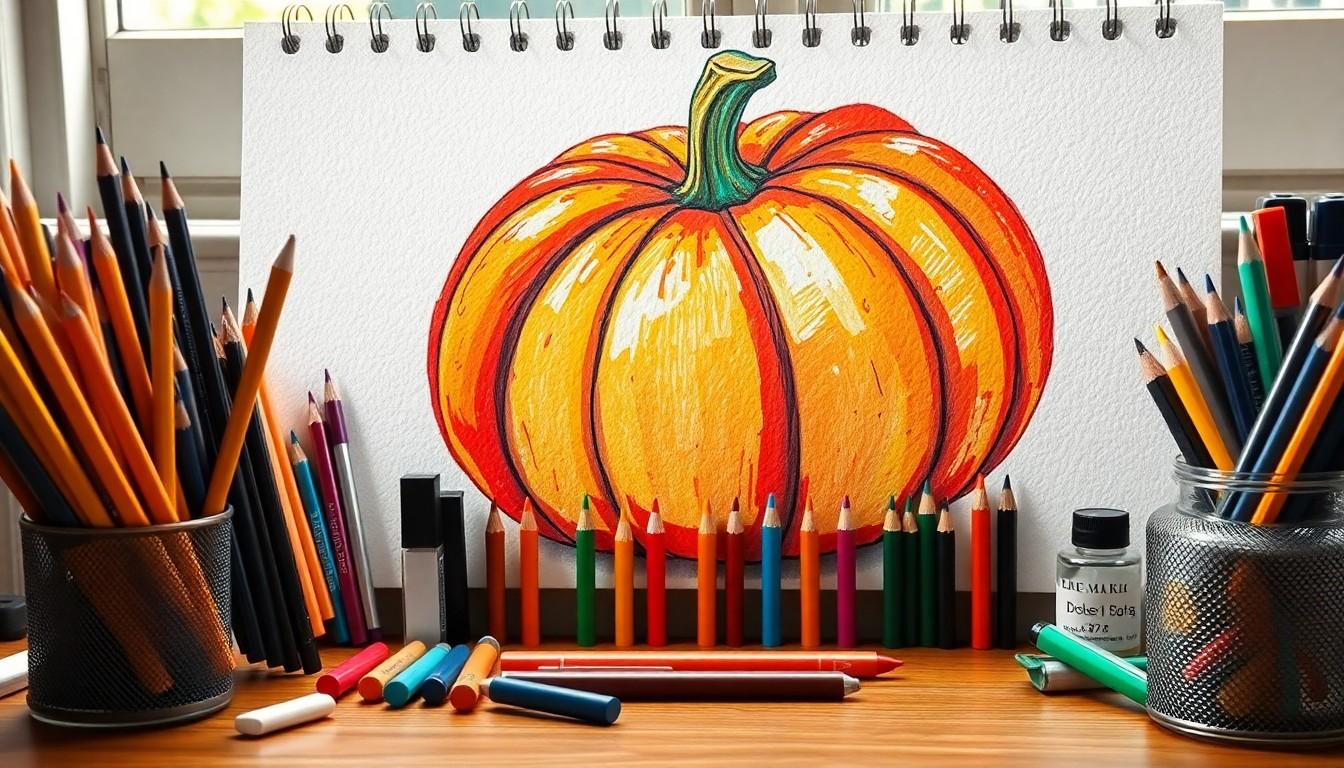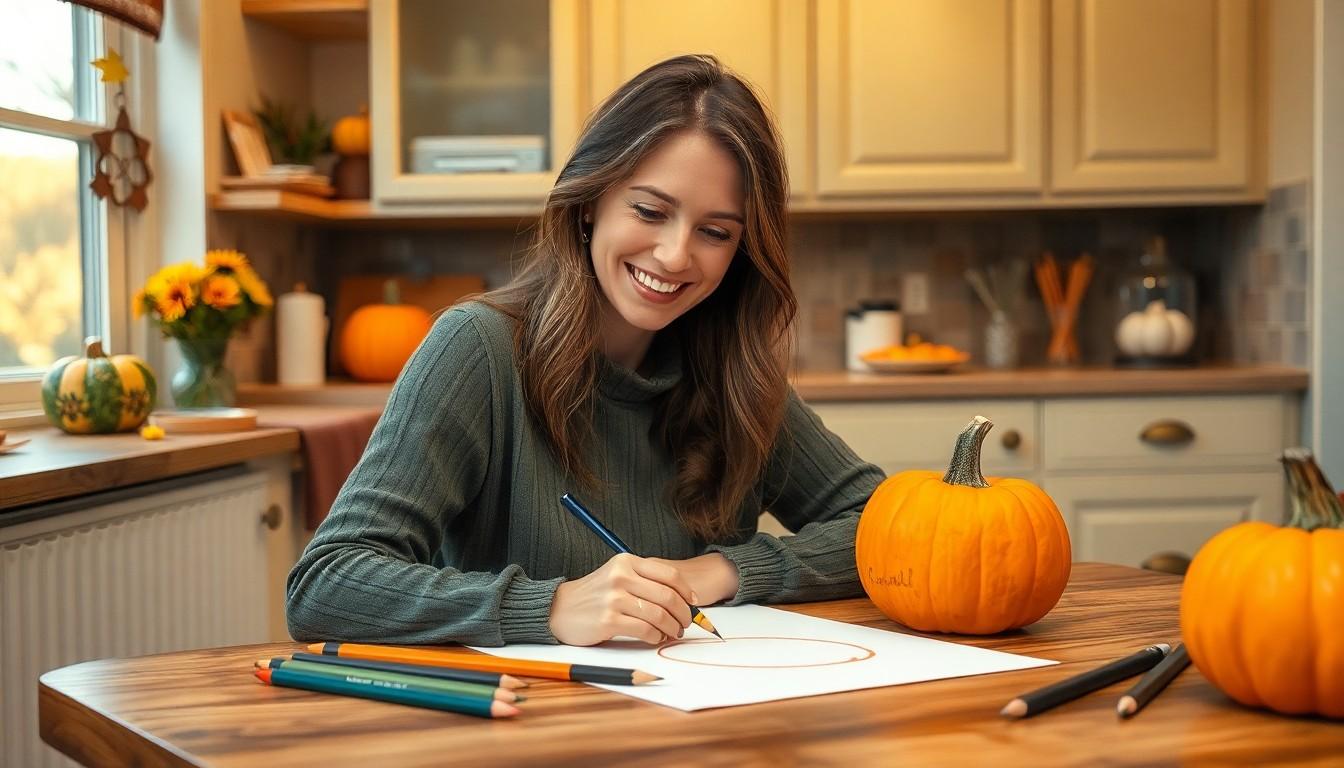When it comes to fall festivities, nothing says “autumn” quite like a cheerful pumpkin. Whether it’s for Halloween or just to celebrate the season, drawing a pumpkin can be the perfect way to unleash creativity. But don’t worry if you think your artistic skills are stuck in kindergarten; simple pumpkin drawings are not only easy but also a fun way to express your inner artist.
Pumpkin Drawing Simple
Drawing pumpkins provides an opportunity to engage with autumn themes. Individuals can create vibrant artwork using basic shapes. Circles and curves form the foundation of many pumpkin drawings. Both kids and adults enjoy this simple artistic activity, making it suitable for all skill levels.
Techniques for pumpkin drawing can vary. A pencil sketch offers a chance to outline shapes before adding details. Color choices can enhance the drawing’s appearance. Classic orange represents pumpkins, yet creative choices may include shades like yellow or green.
Using different materials adds another dimension to pumpkin drawing. Markers, watercolors, or colored pencils can produce distinct effects. Each medium allows for varying levels of detail. Furthermore, incorporating patterns or expressions brings personality to the artwork.
Lighting plays a significant role in pumpkin illustrations. Shadows can create depth, giving the drawing a three-dimensional feel. Artists often study real pumpkins to capture their unique features accurately. Observing the varying textures can enhance the realism of the drawing.
Sharing completed drawings can foster community engagement. Community events or online platforms often showcase pumpkin artwork. Participating in these forums encourages feedback and inspiration from others. Additionally, creativity can flourish through collaborative projects where individuals draw together.
Pumpkin drawing aims to celebrate creativity and seasonal joy. This simple activity highlights the versatility of art. With minimal resources, anyone can enjoy the process of drawing pumpkins. The satisfaction that comes from creating something unique keeps people coming back for more.
Tools and Materials Needed

Gathering the right tools and materials enhances the pumpkin drawing experience. These supplies range from essential items to optional additions for those looking to advance their techniques.
Essential Drawing Supplies
Pencils serve as the foundation for any drawing, allowing for initial sketches and outlines. Erasers provide a means to correct mistakes, ensuring clean lines. Paper designed for drawing accommodates various mediums, offering durability and texture. Colored pencils and markers contribute vibrant hues, essential for bringing the pumpkin to life. For outlining, fine-tip markers offer precision, while watercolors can create soft washes for a dreamy effect.
Optional Tools for Advanced Techniques
Blending tools like tortillons help achieve smooth transitions between colors, elevating the drawing’s depth. Stencils can provide perfect shapes and patterns, making it easier to create consistent designs. Gelly Roll pens add shine and detail, perfect for highlights or intricate features. Various brushes allow for broader strokes or fine details, especially useful if watercolor techniques are employed. Lastly, reference images assist artists in studying real pumpkins and exploring unique styles.
Step-by-Step Guide to Pumpkin Drawing
Drawing pumpkins offers a rewarding experience, enhancing both artistic skills and seasonal enjoyment.
Basic Shapes and Guidelines
Begin by sketching a large circle for the pumpkin’s body. This shape serves as the foundation. Next, add a smaller rectangle or an oval at the top for the stem, positioning it in the center or slightly off-center. For a more dynamic look, incorporate curves along the pumpkin’s sides to mimic the natural ridges found in real pumpkins. Use light pencil strokes for easy adjustments. Once satisfied, refine the outline by tracing over the shapes with firmer lines. It’s essential to maintain proportions for a balanced appearance. Keep practicing these basic shapes to build confidence before adding details.
Adding Details and Textures
Incorporate lines along the pumpkin’s surface to represent its grooves. These lines can vary in length and depth for authenticity. For additional detail, draw tiny circles or irregular shapes to resemble blemishes or shadows. Shades of orange and green enhance realism, bringing vibrancy to your artwork. Consider using a blending tool for smooth transitions between colors. Shadows can be applied beneath the pumpkin to give it a grounded effect. Patterns or personalized expressions, such as faces, can make the drawing more engaging. These elements add character, transforming a simple shape into a lively illustration.
Tips for Improving Your Pumpkin Drawing
Pumpkin drawing can transform simple shapes into expressive artwork. Understanding common pitfalls can significantly enhance the final piece.
Common Mistakes to Avoid
Avoid skipping the sketching phase. Many novice artists rush to outlines without establishing basic shapes. Neglecting shadow placement can lead to flat illustrations. Ensure color selection aligns with realistic values; choosing overly bright hues detracts from authenticity. Also, it’s essential to maintain proportion; misjudging sizes results in awkward compositions. Finally, refrain from overcomplicating details; simplicity often leads to more compelling designs.
Techniques for Enhancing Realism
Using varied textures elevates pumpkin illustrations. Begin by incorporating grooves and imperfections, which adds depth and character. Observe real pumpkins closely to understand nuances. Implement blending techniques to create subtle transitions between colors; this mimics natural shading effectively. Applying highlights enhances dimensionality and captures light beautifully. Experimenting with background elements can also enrich the overall composition and draw attention to the pumpkin. Reference images serve as invaluable resources, providing inspiration and guidance for achieving lifelike results.
Embracing the art of pumpkin drawing opens up a world of creativity and seasonal enjoyment. It invites everyone to explore their artistic side while celebrating fall and Halloween. With simple techniques and minimal materials, anyone can create charming illustrations that reflect their unique style.
The process not only enhances drawing skills but also fosters a sense of community through sharing and collaboration. By experimenting with colors, textures, and techniques, artists can bring their pumpkin drawings to life. Whether a novice or experienced, the joy of drawing pumpkins is accessible to all, making it a delightful autumn activity.

